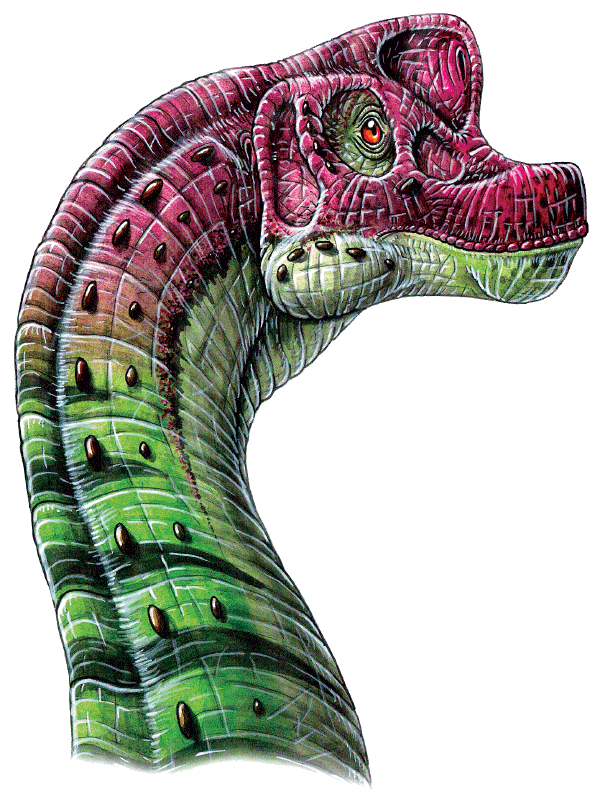|
Giraffatitan
brancai formerly Brachiosaurus brancai (Janensch, 1914) |
 |
|
Name Means: |
"Double Crested Lizard" |
Length: |
80 feet (25 m) |
|
Pronounced: |
die-Loaf-o-Saw-rus |
Weight: |
60 tons (54,500 kilos) |
|
When it lived: |
Jurassic to Cretaceous - 150 MYA |
Family:
|
Brachiosauridae
|
|
Where found: |
Africa |
|
|
|
Giraffatitan brancai was a sauropod, one of a group of
four-legged, plant-eating dinosaurs with long necks and tails, and
tiny brains. Originally considered to be a species of Brachiosaurus, Giraffatitan appears to deserve its own
genus, as no derived characters have been found to link it to Brachiosaurus proper. The skull has an unusually tall rounded
crest containing the nostrils, which is why it was selected for this
poster. This species is unusual in possessing
"withers" over the shoulders.
It and the other Brachiosaurids are members of the .Brachiosauridae
family of dinosaurs. They differ from other sauropods, as all
had a long giraffe-like build, with long forelimbs and a raised neck,
which it probably used to graze in the tops of trees. It has been
suggested that all were basal titanosauriforms thrown together without
respect for true characteristics, such as long necks and long arms.
For many decades, Brachiosaurus was the
largest known dinosaur. It has since been exceeded in sheer mass
by a number of giant titanosaurids like the Argentinosaurus and
it was finally surpassed in height by another brachiosaurid, the Sauroposeidon. It was, however, still the largest dinosaur known
from a relatively complete skeleton and the largest on display
anywhere in the world.
The first Brachiosaurus was discovered in 1900 by Elmer S.
Riggs, in the Grand River Canyon of western Colorado, in the United
States. He named the new species and genera in 1903 after its long
front limbs. Brachiosaurus means "arm lizard", from
the Greek brachion ("arm") and sauros ("lizard").
This first discovered species has named Brachiosaurus
altithorax and it was made famous by the movie "Jurassic Park". It
is very tall (40 feet!) and very heavy - more than 12 elephants!
Unlike most of the other long-necked dinosaurs,
Starting in 1909, German paleontologist Werner Janensch found many
new specimens in Tanzania, Africa, including some nearly complete
skeletons.
These were the Brachiosaurus brancai, which is shown on the
poster. Its fossilized remains are on display at the Humboldt
Museum in Berlin, Germany. The remains are primarily from one gigantic
animal, except for a few tail bones (caudal vertebrae) which belong to
another animal of the same size and species While the Diplodocus carnegiei mounted at the
Carnegie Museum of Natural History in Pittsburgh, United States
actually exceeds it in length, the Berlin animal is
taller, and far more massive. Almost a century after its
discovery, it still remains the largest mounted dinosaur in the world.
It has also been one of the luckiest, because it escape destruction
when most of Berlin was reduced to rubble by allied bombardment during
World War II. |
|
There are three
known species of Brachiosaurus: |
B. alataiensis (de Lapparent
& Zbyszewski, 1957): Is known from back bones (vertebrae), and parts
of the hip and limbs, which were recovered in Estremadura, Portugal.
It lived about 150 million years ago, during the Kimmeridgian age of
the late Jurassic period.
B. altithorax (Riggs, 1903). The type species is
known from two partial skeletons recovered in Colorado and Utah in the
United States. It lived from 145 to 150 million years ago, during the
Kimmeridgian to Tithonian ages.
?B. nougaredi (de Lapparent, 1960): While it
may not be a distinct species (nomen dubium?) it is known from
set of fused bones over the hip (sacrum), and parts of a
forelimb, which were recovered in Wargla, Algeria in Africa. It lived
100 to 110 million years ago, during the Albian to Cenomanian ages of
the middle Cretaceous period.
There at least two other valid members of the family. :
Giraffatitan brancai (Janensch, 1914 (formerly B.
brancai): The new type species, it is known from five partial
skeletons, including at least three skulls, and some limb bones, which
were recovered in Mtwara, Tanzania, in Africa. It lived from 145 to
150 million years ago, during the Kimmeridgian to Tithonian ages of
the late Jurassic period.
Cedarosaurus weiskopfae (Tidwell, Carpenter, and
Brooks, 1999). A new brachiosaurid from the Yellow Cat member of
the Cedar Mountain Formation in Utah. This sauropod is known
from a partial skeleton including vertebrae, partial girdles, and most
of the limbs. Remains referred to Pleurocoelus may belong
here. It was a smallish sauropod. |
|
|
|
|
|
|
|
|
Edugraphics.Net | Feenixx Publishing |
|
|
|